Menu
Physics Lesson 21.3.2 - Classification of Elementary Particles
Please provide a rating, it takes seconds and helps us to keep this resource free for all to use
Welcome to our Physics lesson on Classification of Elementary Particles, this is the second lesson of our suite of physics lessons covering the topic of Classification of Elementary Particles. Quarks and Charm, you can find links to the other lessons within this tutorial and access additional physics learning resources below this lesson.
Classification of Elementary Particles
Based on the type of interaction they experience, elementary particles are classified in three major groups:
- Photons (quants) γ, which are the carriers of EM interaction;
- Leptons, a group composed by muons, electrons, the two types of neutrino and their corresponding antiparticles. All these elementary particles experience the weak interaction during their lifetime; and
- Hadrons ("hadros" from Greek means big and strong). All particles that experience strong interaction such as protons, neutrons, hyperons and their corresponding antiparticles, mesons with or without strangeness as well as a number of resonances (elementary particles with a very short lifespan) are included in hadrons group. The two major subgroups of hadrons are mesons and baryons.
The following tables shows a more structured and complete information on the two most populated groups of elementary particles: leptons and hadrons, as the other group (photons) are well explained already.
Table of leptons
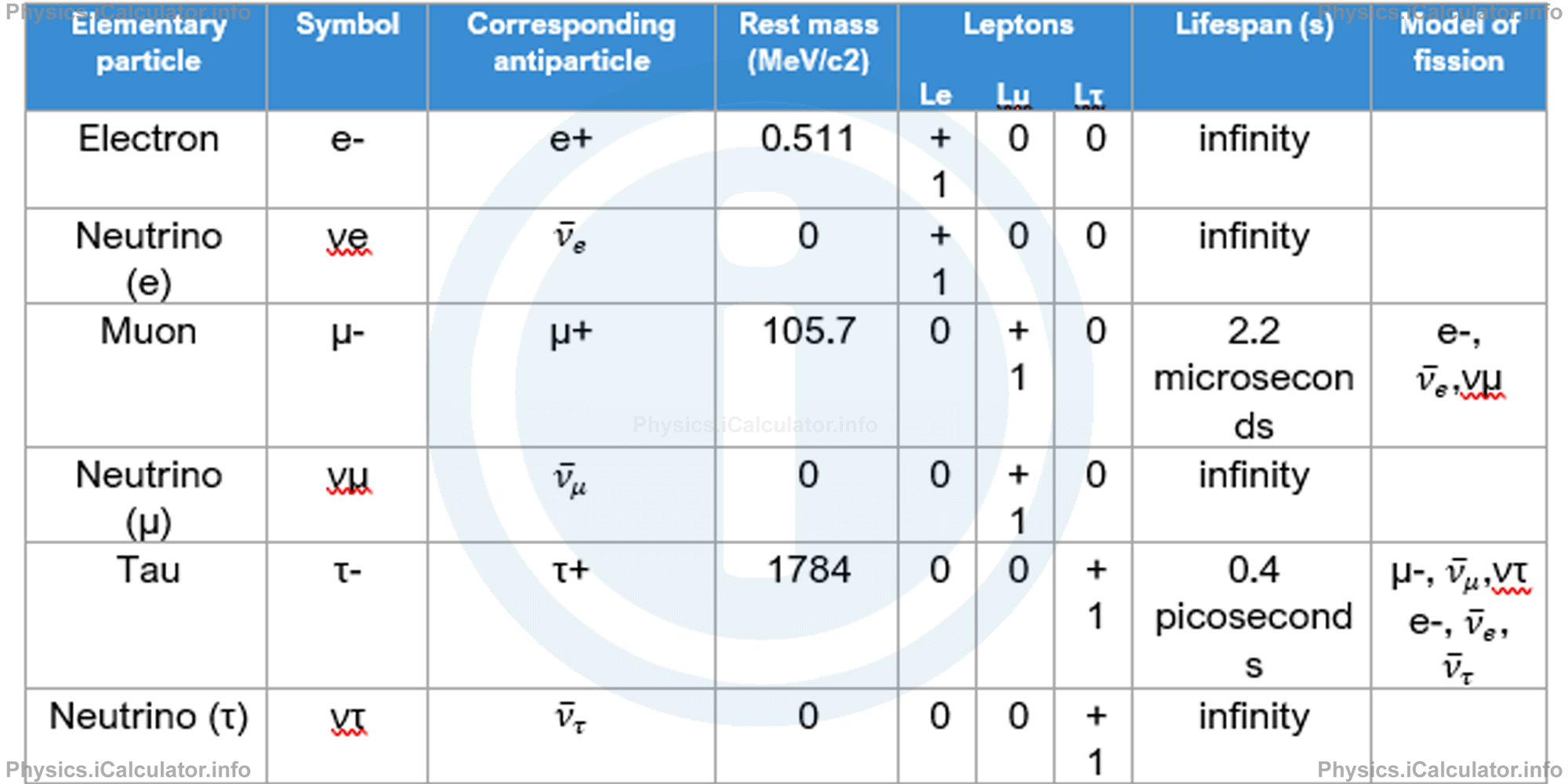
Tables of hadrons
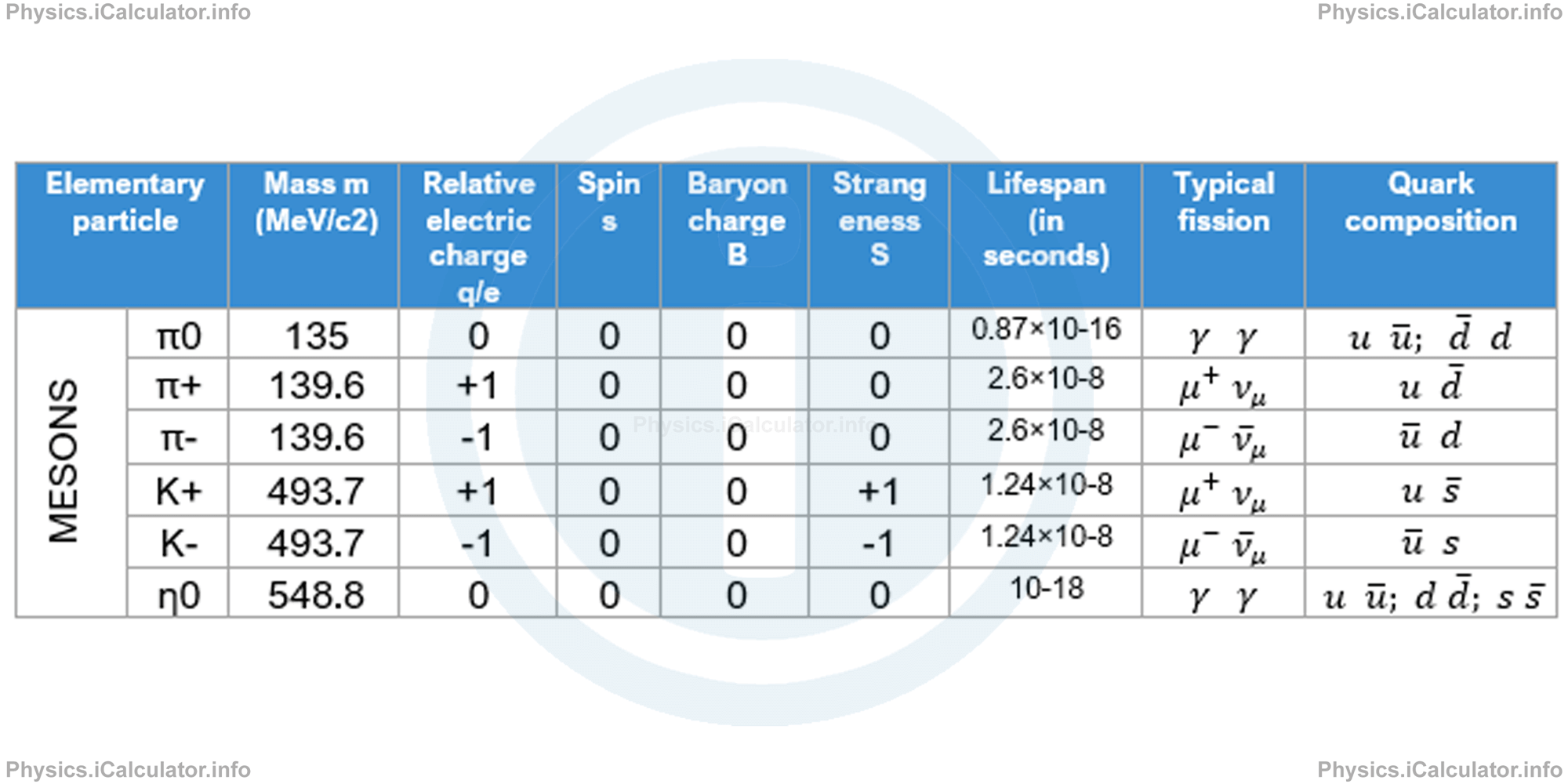
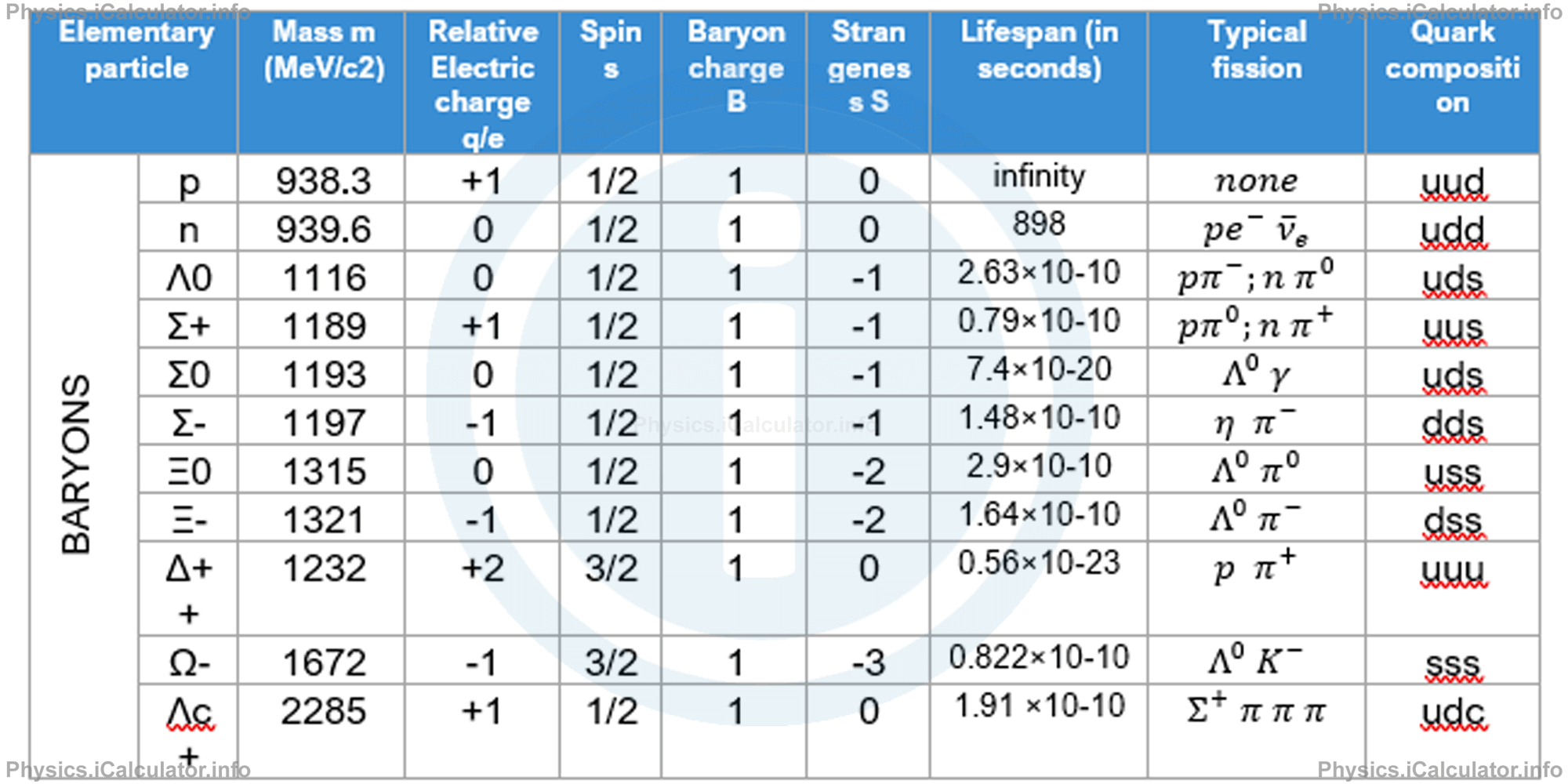
Quarks
In the above tables of hadrons, there is a column (the last one) named "Quark composition." It seems a bit strange, as we have not explained the meaning of "quark" yet. However, since all properties of elementary particles given in the other columns are known, it was included in the tables. We will refer to these tables when discussing about quarks in the current paragraph.
Leptons have the possibility to group in three heavy particles and three neutrinos, each of them having their own antiparticles. On the other hand, the hadrons family cannot represent the fundamental particles of matter, as there exist many other particles that do not belong to this family. However, the main reason why hadrons are not considered as the building blocks of matter is because they (hadrons) are not simple but composite particles instead, where each component has a spin of 1/2. Such components of leptons are known as quarks. If we recap what we said earlier on quarks, it is clear that:
"A quark is one of the fundamental particles in physics. Quarks join to form hadrons, such as protons and neutrons, which are components of the nuclei of atoms. Quarks interact between them mainly through the strong force. The antiparticle of a quark is the antiquark. Quarks and antiquarks are the only two fundamental particles that interact through all four fundamental forces of physics: gravitation, electromagnetism, and the strong and weak interactions."
Quarks exhibit the confinement property, i.e. a specific quark cannot exist separately but only in pair with another quark. A baryon is composed by three quarks (qqq), while a meson is composed by a quark-antiquark pair (qq). Given this, it is evident that a quark has an electric charge equal to 1/3 or 2/3 of the charge of electron, which was previously thought to be the smallest unit of electric charge. Likewise, quarks have a non-whole baryon number.
As for the spin, since each individual quark has a spin of 1/2, two opposite quarks can be combined to give a zero spin. When three quarks are combined, their total spin may be 1/2 or 3/2 based on the presence of antiquarks in the system.
The original theory of quarks included three types of quarks: up (u), down (d) and strange (s) (hence the three letters appearing in the last column of hadrons table of the previous paragraph). However, now the concept of six flavors of quarks is widely accepted. According to this concept, there are six flavors of quarks: up (u), down (d), strange (s), charm (), bottom (B), and top (T). The flavor of the quark determines its properties. For example, quarks with a charge of + (2/3)e are called up-type quarks, and those with a charge of -(1/3)e are called down-type.
There are three generations of quarks, based on pairs of weak positive/negative, weak isospin. The first generation includes the up and down quarks, the second-generation includes strange, and charm quarks, and the third generation includes the top and bottom quarks.
All quarks have a baryon number (B = 1/3) and a lepton number (L = 0). The flavor determines certain other unique properties, described in individual descriptions.
The up and down quarks include protons and neutrons present in the nucleus of ordinary matter. They are the lightest and most stable. The heavier quarks are produced in high-energy collisions and rapidly decay into up and down quarks. Thus, for example, a proton is composed of two up quarks and a down quark. A neutron is composed of one up quark and two down quarks.
The numbers that determine the main properties of quarks are summarized in the table below. 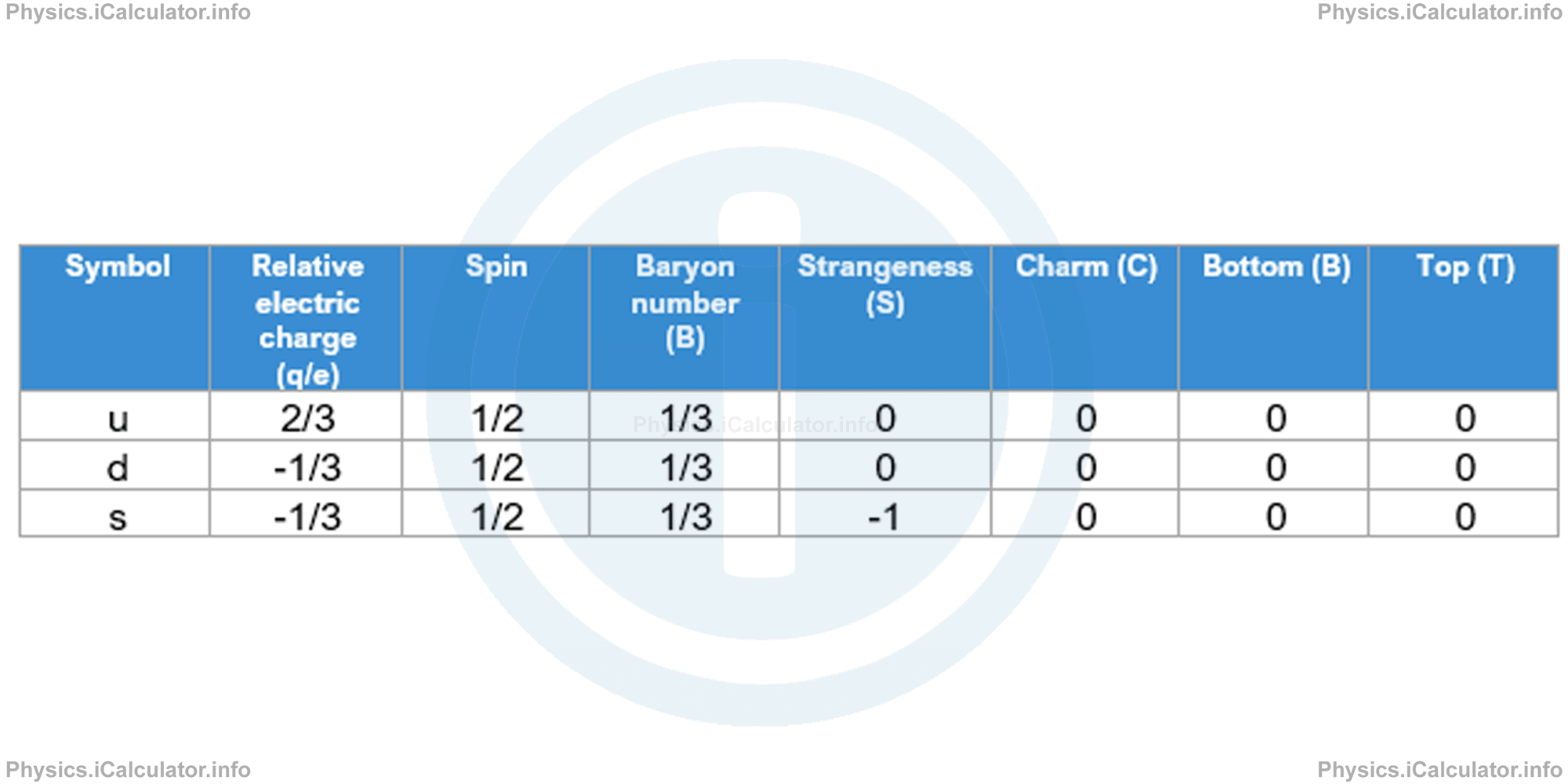
Remarks!
- We will discuss charm (C) - an important property of quarks - in the next paragraphs.
- Do not confuse the baryon number B with bottomness B (this last one represents one of quark's direction of orientation); they represent completely different things despite having the same symbol.
The corresponding antiquarks u,d and s have opposite values to u, s and d for baryon charge, electric charge and strangeness. The elementary particles composed by these three quarks are: protons, neutrons, pions, kaons and especially hyperons. For example, protons are composed by three quarks, uud, as explained earlier. Thus, based on the above table, the electric charge number is
= 2 ∙ 2/3 + (- 1/3)
= 4/3 - 1/3
= 3/3
= 1
This means the electric charge of proton is 1q (as expected). As for the baryon charge (number) of proton, we have:
= 2 ∙ 1/3 + 1/3
= 2/3 + 1/3
= 3/3
= 1
This is also a known fact indicated in the table of baryons.
Example 1
Calculate the electric, baryon and strangeness numbers of K+ meson, antiproton and π- meson if the corresponding quark compositions are:
K+ meson = us
π- meson = u d
Check the results with the values given in the hadrons tables.
Solution 1
From the values given in the quarks table, we have:
For antiproton:
q/e (p) = 2 ∙ q/e (u) + q/e (d)
= 2 ∙ (-2/3) + [-( - 1/3)]
= - 4/3 + 1/3
= - 3/3
= -1
B(p) = 2B(u) + B(d)
= 2 ∙ (- 1/3) + (- 1/3)
= -3/3
= -1
S(p) = 2S(u) + S(d)
= 2 ∙ 0 + 0
= 0
For K+ meson:
q/e (K+ ) = q/e (u) + q/e (s)
= 2/3 + [- (- 1/3)]
= 3/3
= + 1
B(K+ ) = B(u) + B(s)
= 1/3 + (- 1/3)
= 0
S(K+ ) = S(u) + S(s)
= 0 + [-(-1)]
= + 1
For >π- meson:
q/e (π-) = q/e (u-) + q/e (d)
= -2/3 + (- 1/3)
= - 3/3
= -1
B(π-) = B(u-) + B(d)
= -1/3 + 1/3
= 0
S(π-) = S(u-) + S(d)
= 0 + 0
= 0
You can have a check at the baryons table to find out that all the above values correspond to those provided in the table.
The figure below illustrates the quark composition of four hadrons: proton (p), neutron (n), positive pion (π+) and positive kaon (K+).
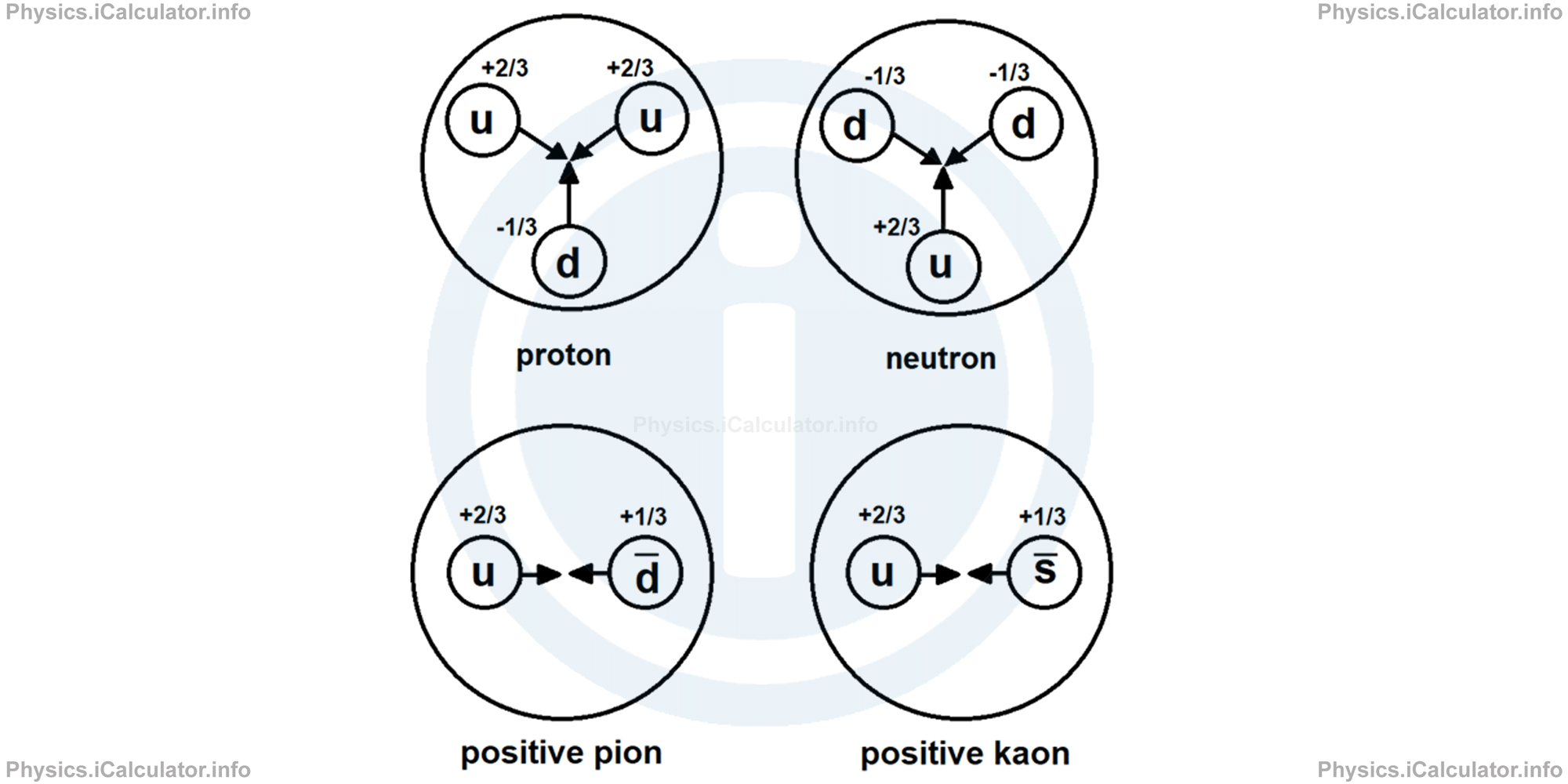
Quark Mediators
Since quarks are charged particles, the question that arises here is: "What is the factor that holds them together?" Experiments show that quarks and antiquarks interact with each other by exchanging virtual particles called gluons (from "glue"). They are particles that have the spin equal to 1 and behave in a similar way to photons (through which the electromagnetic interaction is realized) or pions (which are the elementary particles in-charge for the strong interaction in Yukawa theory).
Since quarks have the spin 1/2, they belong to the fermions class (fermion is a subatomic particle, such as a nucleon, which has half-integral spin and follows the statistical description given by Fermi and Dirac). Fermions are subject to the exclusivity principle, i.e. two fermions cannot have more than one quark of the same type. To have a better understanding of quark types, scientists have classified them in "colours". They have proposed three colors to identify various types of quarks: red, green and blue. The exclusivity principle is applied for each color separately. Thus, a baryon composed by three quarks of different colors is colorless in itself as based on the theory of colors in optics, when red, green and blue are combined they give the white light. Each gluon is associated with one color and one anti-color. During the process of absorption or emission of a gluon by a quark, the color is conserved. The process of gluons exchange occurs in such a way that there is always a quark of each color in every individual baryon. However, the color of any specific quark changes continuously. The following figures clarifies this point.
The first figure below shows a pion containing a blue quark and an anti-blue antiquark. In the second figure, the blue quark emits a blue-anti-red gluon, transforming in this way into a red quark. In the third figure, the gluon is absorbed by the anti-blue antiquark, which is transformed into an anti-red antiquark. The pion is already composed by a red quark - antired antiquark pair. The actual quantum state of a pion is a superposition of red-antired, blue-antiblue and green-antigreen pairs.
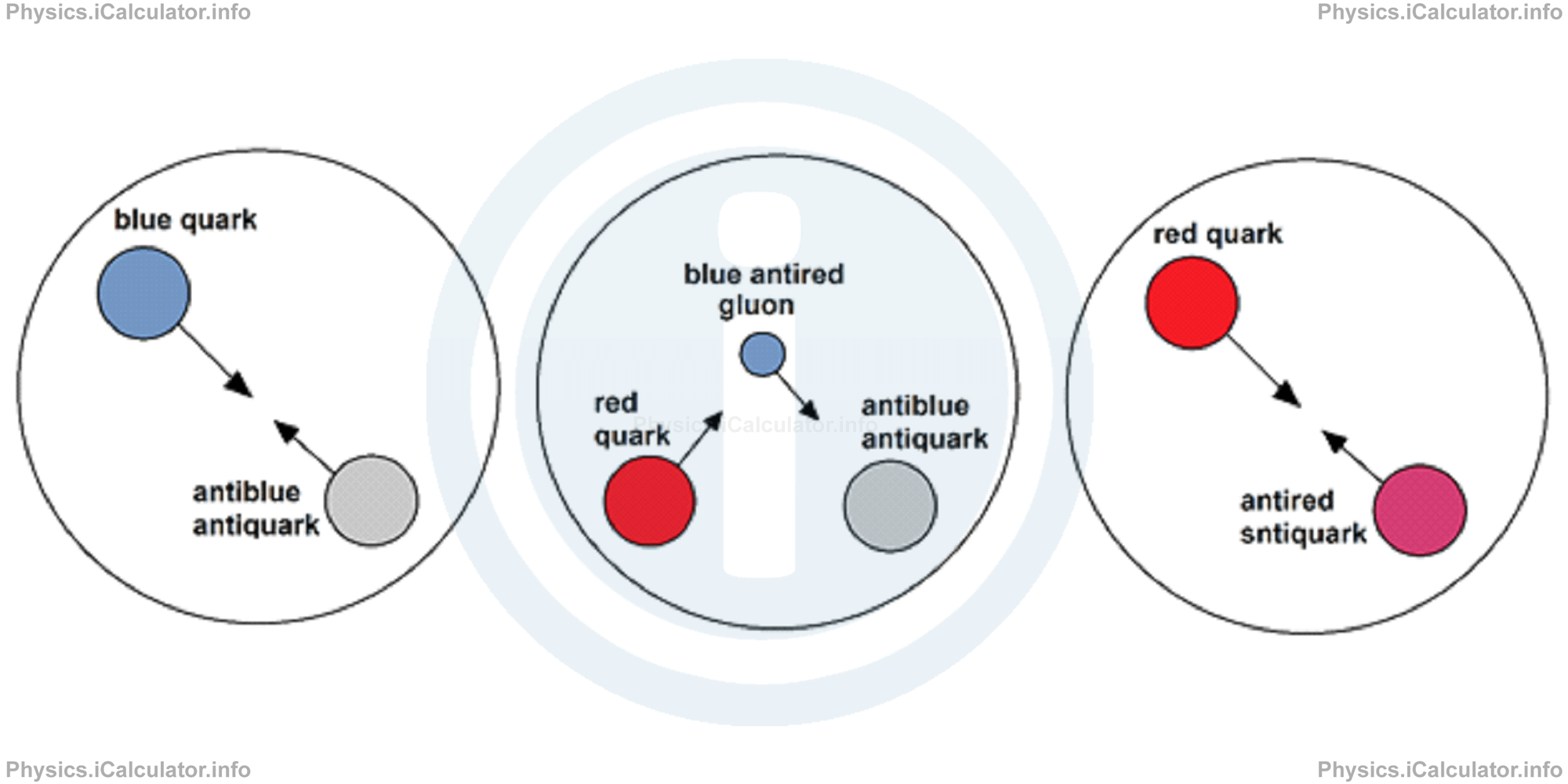
The gluon exchange connects two quarts in a pion, which are always "colored". Let's suppose that initially, a pion is composed by a blue quark and an anti-blue antiquark. The blue quark can emit a virtual bue-antired gluon, turning into a red quark. The gluon at this moment is absorbed by the anti-blue antiquark which gives an anti-red antiquark as shown in the above figures. The color is conserved in every emission and absorption; however, a blue-antiblue pair is transformed into red-antired one. Hence, we assume a pion as a superposition of three quantum states: blue-antiblue, red-antired and green-antigreen. The same process is observed in mesons a as well.
You have reached the end of Physics lesson 21.3.2 Classification of Elementary Particles. There are 6 lessons in this physics tutorial covering Classification of Elementary Particles. Quarks and Charm, you can access all the lessons from this tutorial below.
More Classification of Elementary Particles. Quarks and Charm Lessons and Learning Resources
Whats next?
Enjoy the "Classification of Elementary Particles" physics lesson? People who liked the "Classification of Elementary Particles. Quarks and Charm lesson found the following resources useful:
- Classification Feedback. Helps other - Leave a rating for this classification (see below)
- Elementary Particles Physics tutorial: Classification of Elementary Particles. Quarks and Charm. Read the Classification of Elementary Particles. Quarks and Charm physics tutorial and build your physics knowledge of Elementary Particles
- Elementary Particles Revision Notes: Classification of Elementary Particles. Quarks and Charm. Print the notes so you can revise the key points covered in the physics tutorial for Classification of Elementary Particles. Quarks and Charm
- Elementary Particles Practice Questions: Classification of Elementary Particles. Quarks and Charm. Test and improve your knowledge of Classification of Elementary Particles. Quarks and Charm with example questins and answers
- Check your calculations for Elementary Particles questions with our excellent Elementary Particles calculators which contain full equations and calculations clearly displayed line by line. See the Elementary Particles Calculators by iCalculator™ below.
- Continuing learning elementary particles - read our next physics tutorial: Elementary Particles
Help others Learning Physics just like you
Please provide a rating, it takes seconds and helps us to keep this resource free for all to use
We hope you found this Physics lesson "Classification of Elementary Particles. Quarks and Charm" useful. If you did it would be great if you could spare the time to rate this physics lesson (simply click on the number of stars that match your assessment of this physics learning aide) and/or share on social media, this helps us identify popular tutorials and calculators and expand our free learning resources to support our users around the world have free access to expand their knowledge of physics and other disciplines.